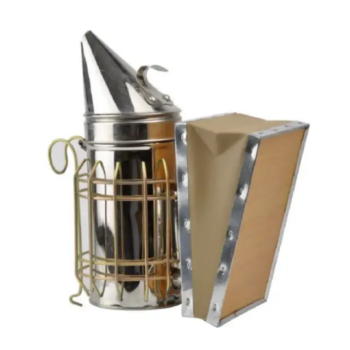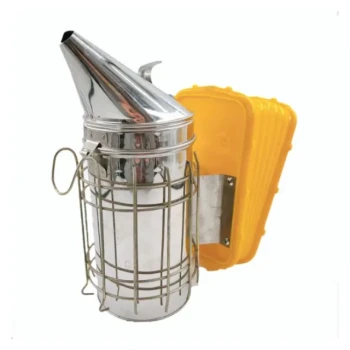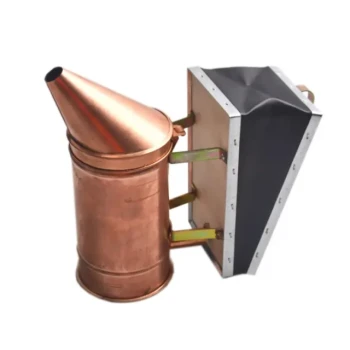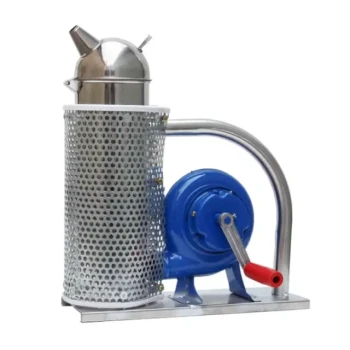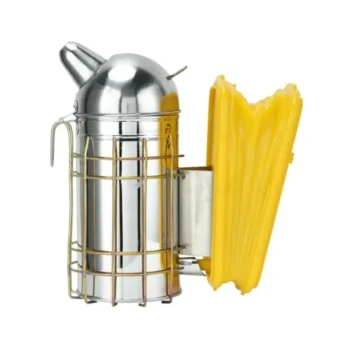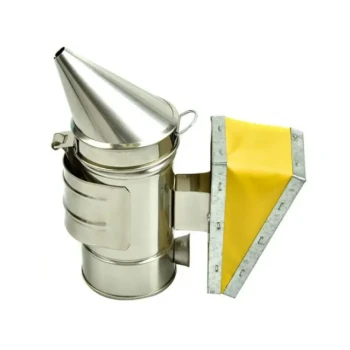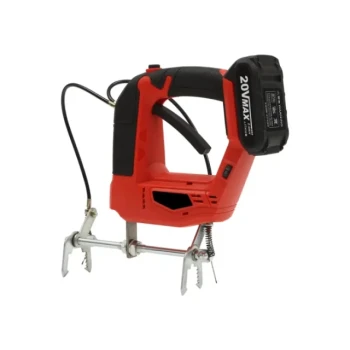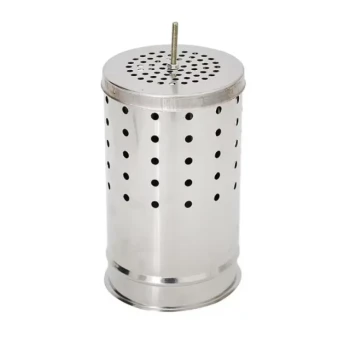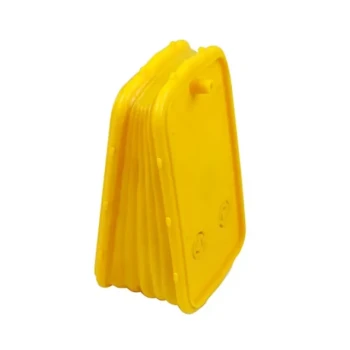To put it simply, beekeepers collect honey without getting stung by using a strategic combination of specialized equipment, behavioral techniques, and a deep understanding of bee biology. The primary tools are protective gear like a veil and suit, a smoker to calm the bees, and specific methods like escape boards to separate the bees from the honey-filled sections of the hive before they are removed.
The core principle behind a sting-free harvest is not to fight the bees, but to work with their instincts. By masking their alarm signals and providing a non-threatening presence, beekeepers can manage the colony's defensive response and perform their work in a calm, controlled environment.
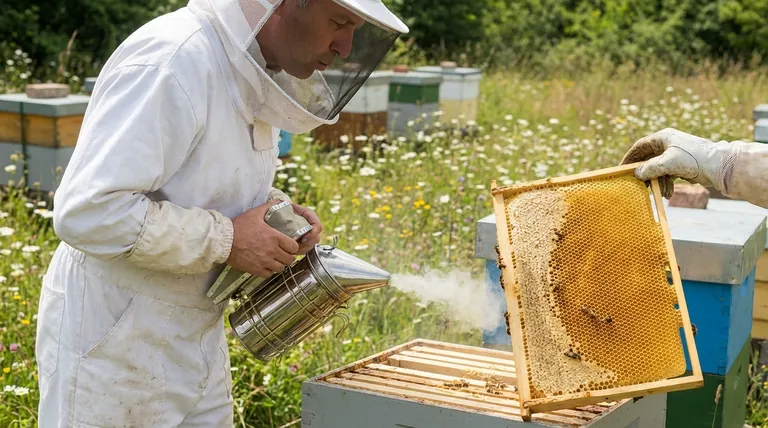
The Foundation: Creating a Calm Environment
A successful harvest begins long before the honey is collected. The primary goal is to prevent the bees' defensive instincts from being triggered in the first place.
The Role of the Smoker
A bee smoker is the most iconic tool for a reason. Cool, white smoke puffed gently into the hive entrance and over the frames has two main effects.
First, it masks the alarm pheromone that guard bees release when they perceive a threat. This prevents a chain reaction of defensiveness from spreading throughout the colony.
Second, it triggers a feeding response in the bees. They begin to consume honey, which makes them more docile and less inclined to fly out and sting.
The Importance of Gentle Handling
Bees respond to their environment. Slow, deliberate, and gentle movements are critical.
Sudden, jerky motions or banging equipment can be interpreted as a threat, immediately putting the hive on alert. Experienced beekeepers move with a calm confidence that the bees do not perceive as aggressive.
Selecting for Temperament
Professional beekeepers know that colony genetics play a significant role in temperament.
By raising or purchasing bees with gentle, commercially reared queens, they can cultivate hives that are naturally less defensive and easier to work with.
The Harvest Strategy: Separating Bees from Honey
Even with a calm colony, the honey boxes (called "supers") are full of bees. The key is to remove the bees from these supers before taking them away for harvesting.
Using an Escape Board
An escape board is one of the most gentle methods. It's a special board with a one-way exit placed between the honey supers and the main hive body.
Bees can travel down through the escape board into the lower parts of the hive but cannot get back up. The beekeeper simply installs the board and returns 24-48 hours later to find the honey supers nearly empty of bees.
Using a Fume Board
For a faster method, beekeepers use a fume board. This is a lid with an absorbent material on the inside.
A non-toxic, bee-repellent liquid is applied to the board, which is then placed on top of the honey supers. The fumes, which are unpleasant to the bees, gently drive them down and out of the supers, clearing them in a matter of minutes.
Brushing Bees Manually
For smaller-scale operations, a beekeeper may simply take one frame of honey out at a time and use a soft-bristled bee brush to gently sweep the bees off the frame and back into the hive.
Understanding the Common Pitfalls
Avoiding stings also means avoiding common mistakes that can quickly turn a calm hive into a defensive one.
Harvesting at the Wrong Time
Weather and timing are crucial. Attempting a harvest on a cold, rainy, or windy day is a recipe for disaster, as most of the bees will be inside the hive and more easily agitated.
The ideal time is a warm, sunny day when the majority of the colony's foragers are out collecting nectar.
Overusing Smoke
While a smoker is essential, too much smoke can be counterproductive. Excessive smoke can irritate the bees, cause them to consume too much honey, and even taint the flavor of the harvest.
Rushing the Process
Impatience is the beekeeper's enemy. Dropping a frame, crushing bees, or moving too quickly will trigger a defensive response, undoing all the work done to keep the colony calm.
Making the Right Choice for Your Goal
The method you choose depends on your goals and the scale of your operation.
- If your primary focus is minimal disturbance and bee welfare: Use an escape board, as it is the most passive and gentle method available.
- If your primary focus is speed and efficiency for a larger operation: A fume board or a specialized bee blower is the standard for clearing supers quickly.
- If you are a new beekeeper with one or two hives: Start with a full suit, a smoker, and manually brushing bees off each frame to build your confidence and handling skills.
Ultimately, a safe and successful honey harvest is a direct reflection of the beekeeper's respect for the colony and understanding of its natural rhythms.
Summary Table:
| Method | Best For | Key Benefit |
|---|---|---|
| Escape Board | Minimal Bee Disturbance | Passive, one-way exit clears supers gently over 24-48 hours. |
| Fume Board | Speed & Efficiency | Clears honey supers of bees in minutes for large-scale operations. |
| Bee Brush | Small-Scale/New Beekeepers | Allows for careful, frame-by-frame harvesting with direct control. |
Ready to equip your apiary for a safer, more efficient harvest?
As a trusted wholesale supplier to commercial apiaries and distributors, HONESTBEE provides the durable, professional-grade equipment you rely on—from high-quality bee suits and smokers to efficient escape boards and fume boards.
Let us help you protect your team and maximize your yield. Contact our expert team today to discuss your beekeeping supply needs.
Visual Guide
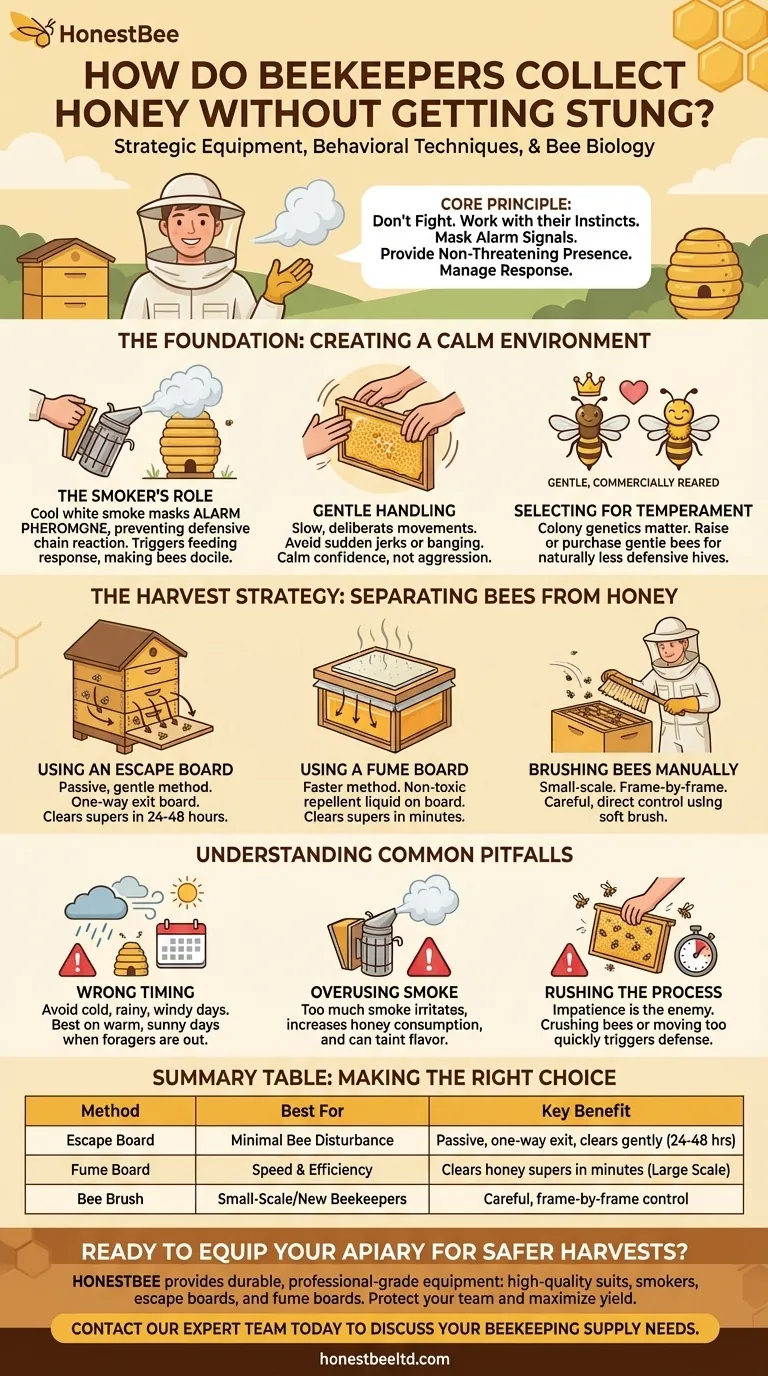
Related Products
- European Stainless Steel Bee Smoker for Honey Bee Hive
- Economy Galvanized Beekeeping Honey Bee Smoker for Wholesale
- Stainless Steel Honey Bee Smoker Hive and Honeycomb Smoker for Beekeeping
- Professional Bee Smoker with Elongated Spout and Durable Bellows for Beekeeping
- Premium Traditional Copper Bee Smoker with Bellows
People Also Ask
- What are the features of a recommended bee smoker? A Guide to Safety, Durability & Performance
- Can you use too much smoke on bees? The Right Way to Use a Bee Smoker for Calm Inspections
- What factors should be considered when choosing a bee smoker? Find the Right Tool for Safe, Effective Hive Management
- How does a smoker help during hive inspections? The Key to Calm, Safe Beekeeping
- What are the differences between stainless steel and galvanized steel bee smokers? Choose the Right Smoker for Your Apiary


